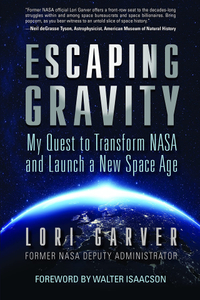'Escaping Gravity': Former NASA deputy chief Lori Garver weighs in US space program in new book
"Escaping Gravity" tells the story of Lori Garver's rise to be NASA's second in command, and how she brought one of the agency's most successful programs to reality.
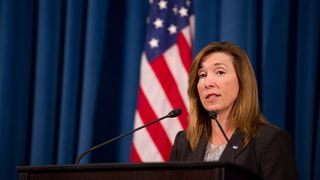
In her new book, the space industry veteran Lori Garver, a former NASA Deputy Administrator ,chronicles her space career and highlights her struggle navigating a bloated bureaucracy to help realize the agency's true potential through the utilization of commercial crew.
Garver recently sat down with Space.com to talk about the book, called "Escaping Gravity: My Quest to Transform NASA and Launch a New Space Age" (Blackstone Publishing, 2022), as well as her views on the space agency, and the rocky relationships she had to maneuver with some of NASA's past and current top leadership officials.
When we spoke, I asked her if any former colleagues had reached out, bothered by her blunt transparency since the book's release on June 21. She's quick to point out that the book doesn't actually attack anyone personally, but instead only holds a magnifying glass to people's actions, even when they may have been unflattering.
"I have heard from a lot of former colleagues who have said, 'touché, finally, this was a story that needs to be told.' I was a little worried that a couple [of them who are] pretty senior in the administration might say, 'oh, you're airing some laundry there …' I think that the people who were on the other side of the policy argument are not commenting, which I expected, and, frankly, which I hoped," Garver said in our interview.
Related: The best space books of 2022
Escaping Gravity: My Quest to Transform NASA and Launch a New Space Age $28.99 now $26.49 at Amazon.
Former NASA Deputy Administrator Lori Garver recounts her career at NASA and aim to shift the agency into a new era of commercial collaboration in space in her new memoir.
"Escaping Gravity" is autobiographical, but Garver does an excellent job contextualizing her role in the history behind the beginnings of one of NASA's most daring and successful ventures in recent history: contracting private companies to fly NASA astronauts to space. To many, especially these days, a SpaceX rocket launching a crew to the International Space Station (ISS) is not only no longer novel, but is viewed as completely routine.
The decision to retire the space shuttle in 2011 left NASA with a singular option for transportation to the ISS — buying seats aboard Russian Soyuz rockets. Even before the shuttle's retirement, NASA's human spaceflight program stumbled with cost overruns and delays rooted in the muck of bureaucracy, political self-interests, legacy contracts and a dated way of doing business.
Get the Space.com Newsletter
Breaking space news, the latest updates on rocket launches, skywatching events and more!
Garver cites the space shuttle Columbia and space shuttle Challenger accidents as extremely disruptive to the future of human spaceflight. She outlines how the government's dash to support launch vehicle development for Lockheed Martin and Boeing following the Challenger disaster led to the creation of United Launch Alliance (ULA), and the "giant self-licking ice cream cone" of billion dollar subsidies ULA and other legacy contractors receive annually.
"The system eliminates the proven method for driving efficiency and innovation — competition," she writes. "Members of Congress and industry who have perfected the system of lapping up all the ice cream for themselves understandably enjoy the sugar high, but over the longer term, it undermines the health of the [space] sector and the nation."
In our interview, Garver told Space.com that "the process and bureaucracy, and the system with Congress gets really cumbersome and keeps you from making progress. I don't question that everybody wants to project progress. They're just really in a tunnel that has only allowed them to see that they can do things a certain way."

Before Garver worked for NASA, she worked to help guide NASA as part of the National Space Society (NSS), a nonprofit organization comprised of space-advocacy professionals whom Garver affectionately refers to throughout the book as "space pirates."
"These are the people who raised me — my original space family," Garver writes in "Escaping Gravity," and she makes it clear she holds them to the highest regard.
Broadly, the mission of the NSS is to advocate for spaceflight strategies toward the establishment of humanity as a spacefaring civilization. The efforts put forth by the organization to execute that strategy are equally broad, and include the 1984 Commercial Space Launch Incentives Act, which proposed tapping the private sector to more quickly expand technological advancements in the field. Of NSS members' accomplishments toward their goals, Garver writes with admiration:
"They have advanced important policies and legislation, kept the United States from signing treaties that would have blocked space development, started new companies and organizations, lobbied members of Congress, antagonized senior aerospace industry leaders, and often been ignored and marginalized by the established space community."
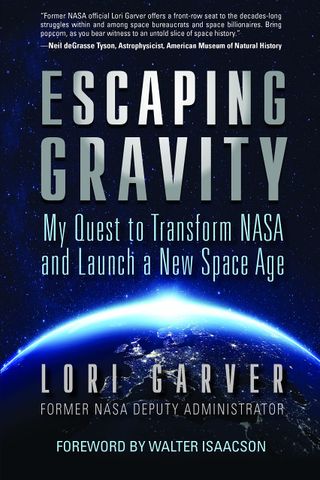
In 1988, Garver was promoted to Executive Director of the NSS while also earning her Master's degree in international science and technology policy, with a focus on space. That same year, she volunteered as a space policy advisor to the Michael Dukakis presidential campaign, hoping to guide a "worthwhile" space program in the event of a Democrat victory, she writes in her book. Dukakis lost that election to President George H.W. Bush.
As Executive Director, Garver quickly filled positions within the NSS board with recognizable figures. She appointed three-time shuttle astronaut Charlie Walker as the organization's president, Buzz Aldrin as board chairman, and began bumping elbows with the likes of Apollo astronaut Jim Lovell, Star Trek creator Gene Roddenberry and Hollywood A-lister Tom Hanks, just to name a few. As NSS director, Garver was not only able to boost the status of the organization, but her own reputation as well.
"Elevating NSS's reputation in the space community gave us the ability to convey a long-term purpose for space development," Garver writes in her book. In contrast, however, that statement is immediately followed in the book by her view that "NASA's narrow focus on the handful of elected leaders obsessed with preserving NASA jobs in their districts was in contrast to the Society's vision of creating a spacefaring civilization that would establish communities beyond Earth."
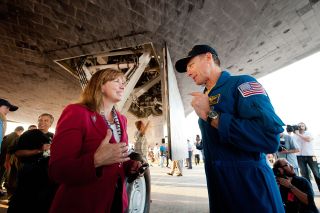
On the 20th anniversary of the Apollo 11moon landing in 1986, President Bush announced the creation of the Space Exploration Initiative (SEI) to "return humans to the Moon and go on to Mars ... [and] establish the United States as the preeminent spacefaring nation."
SEI could be viewed as one the Artemis program's early precursor attempts. However, like similar programs that would follow, SEI fell victim to a lack of full support from Congress, which balked at NASA's $500 billion cost estimation.
"Instead of reshaping projects to the President's articulated goal of becoming spacefarers, it was a rehashed version of Apollo for even more money. The price tag drew headlines in the media, skepticism from Congress, and the ire of the Space Council," Garver writes in the book, as the "giant self-licking ice cream cone" continued to deliver its sugar high.
Garver was appointed to NASA's Advisory Council in 1994, and began her first full-time position at the agency two years later as Associate Administrator for the Office of Policy and Plans. This set the course for a twenty-year effort to help realize the commercial space realities that exist today.
Garver says she sees a contrast in her background, compared to many in NASA. In her book and in our interview, she mentions the transformative power known as the Overview Effect — the psychological shift in perspective astronauts have described after seeing Earth from space for the first time. Garver draws a direct link between humanity's first view of our home planet and the age of scientific interests focused on Earth's climate.
"Those are direct things like the environmental movement, and modeling our climate to understand it, and to know we can have an impact that will allow us to have humanity be healthy, here on planet Earth. As well as to see that we are all in this together. That perspective is what NASA needs too. Something that is different. And I think the reason I was able to come in and see that is because I didn't grow up just wanting to build a big rocket."
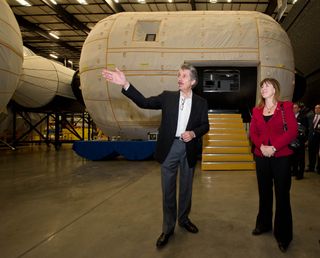
Her position at NASA in the '90s also marked Garver's first encounter with an aerospace subset the author refers to as "cup boys." Indicative of the "boys' club" mentality Garver and other female colleagues encountered in NASA's offices and in the aerospace industry in general, the moniker refers to individuals in the male-dominated field carrying around coffee mugs printed with their military call signs, "Mini, Zorro, Dragon, Panther, and so on," Garver writes. She describes the insular clique as resistant to new people and new ideas, which Garver viewed as opposite the space agency's core values.
These "cup boys" could serve as a quick answer to the source for many of the roadblocks Garver faced in her efforts to alleviate NASA's budgetary overhead through the commercial cargo and crew programs. As one excerpt from her book reads:
"NASA's leaders were typically astronauts and engineers who didn't question the public value or relevance of their activities. Indeed, many considered flying themselves and their friends into space to be an entitlement that shouldn't require justification. They had little interest in transitioning what they enjoyed and got paid to do over to the private sector and they assumed that was their decision."
Garver held her position as associate administrator from 1996 to 2001, after which she stayed in D.C. to work as a consultant to the aerospace industry. She rejoined NASA in 2008, but writes about some notable occurrences she experienced in those interim years. One, in particular, involved several months of cosmonaut training to possibly fly on a Russian Soyuz rocket.
Though launching herself was not Garver's first choice, she certainly didn't shutter at the opportunity when the stars seemed to be in alignment for it. Garver tells of a deal struck between her consulting firm, the Russian space agency, a private agent and the Discovery Channel to secure a seat for herself in a commercial space publicity flight they named "Astromom."
The publicity drummed up a little competition for the seat, and Garver eventually found herself in training alongside NSYNC pop star Lance Bass. Unfortunately, Lance's involvement ultimately served to derail both their chances, and neither ended up going to space.
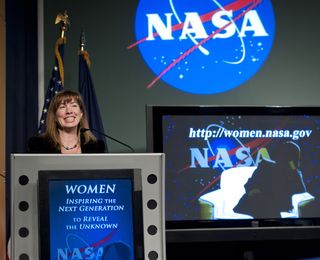
Garver continued her aerospace consulting until 2008, when NASA called again. This time, presidential candidate Barack Obama was on the line. Garver led the president-elect's transition team at NASA, and was later appointed as the agency's Deputy Administrator.
However, during her time on the NASA transition team, and throughout her years as Deputy Administrator, Garver ran into some of her biggest frustrations with the space industry's "cup boys" and their "self-licking ice cream cone."
Garver writes about her transition team being blocked at every turn in their attempts to learn anything substantial about the Constellation program, which had been planned to replace the aging Space Shuttle. She writes about former colleagues being forced to shun her in the hallways at NASA, saying "the message conveyed from the top was that being seen even talking with [the transition team] would be 'career limiting.'" The wife of the sitting NASA administrator at the time even teamed up with a "former astronaut-turned NASA contractor" to circulate a petition calling for Garver's removal entirely.
Garver rejoined NASA at a time when the space shuttle was already slated for retirement, and NASA's Constellation program was purportedly in line to replace it. Like the Space Exploration Initiative of the 1980s, the Constellation program had lofty goals of returning NASA astronauts to the moon. But by that point, it would have been enough for the program to provide continued access to the ISS, but, as Garver points out, the Ares 1 rocket and Orion capsule designed to do so weren't on track to launch until after the space station's scheduled retirement at the time.
The same 2004 policy which directed the end of the shuttle missions and earmarked billions for the Constellation program also kickstarted the funding that would eventually land SpaceX contracts for the company's cargo and crew Dragons, but getting there would be an uphill battle Garver had to fight without the support of NASA's top official.
Garver's description of Constellation echoes her observations of the SEI. "Constellation had been designed to utilize the infrastructure and workforce that had been built for the Apollo program. Being sized to use fifty-year-old existing, expensive facilities at their capacity in an attempt to gain political support was never going to be efficient."
Garver told Space.com she approached her role as Deputy Administrator from the lens of her political science and economics background. "How can we align these programs to better humanity, to give ourselves the very best space program we can have, and to inspire it to continue? Because I say, on the backs of taxpayers, I'm a liberal! I believe in government, but I believe in government for doing those things to really lift up the people who need it most. And space can do that. And we haven't done as much as we need to be."
Garver played second fiddle throughout her time as Deputy Administrator to NASA Administrator Charles Bolden, though Bolden was not the Obama administration's first selection for the role. When it came time to select a new NASA administrator after the 2008 election, opposition from former Senator Bill Nelson thwarted the White House's first choices, which put into process a committee to find another selection.
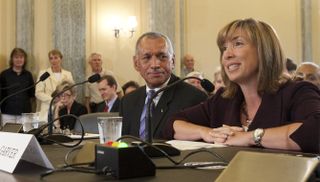
Garver points out that Nelson and Bolden both flew together on a mission aboard space shuttle Columbia in 1986. She writes, "never in my wildest imagination could I have envisioned how the bond they developed on that flight would impact the space program and my own career."
"I couldn't believe a single Democratic senator's personal views were enough to sideline the President's extremely well-qualified nominee," she writes in the book. "It didn't bode well for progress."
Nelson was a senator from Florida, home to an overwhelming number of NASA launches and contracting facilities. In her book, Garver points to a conversation between herself and then candidate Obama, in which the future president indicated Nelson's advice that the Shuttle program be extended beyond its already protracted retirement plan. Bill Nelson was appointed NASA Administrator under President Joe Biden in 2021.
Garver's reaction to Nelson's nomination was to be expected. "I was disappointed for very public reasons," Garver told Space.com. "[Nelson's nomination] sent an unfortunate signal that the new president doesn't really understand what the best of NASA is right now. And I think with [Nelson] coming in there just sealed that we were going to keep on with this bifurcated, too-much-on-NASA's-plate, stretch-the-budget kind of a program, which hasn't been getting us very far."
Speaking with Space.com, Garver revealed, "I think Bill Nelson had an agenda. And Charlie was part of it."
Related: Former Senator Bill Nelson sworn in as new NASA Administrator
In contrast, it isn't clear if Administrator Bolden had any agenda at all. In the book, Garver recalls the pair's first solo dinner together following their nominations, where she asks him his goals for NASA. "Oh, I don't know. What about you?" was the former administrator's response.
"He did not have an agenda, and he didn't think he should even [have one]," Garver told Space.com. "I don't know whether it was his military background, but it was just … I don't think he saw any problems [not having his own agenda]."
Garver did not agree, and she didn't shy away from expressing her views at the space agency. She writes about speaking with Obama early in the campaign, and her view that NASA's investment in commercial spaceflight could alleviate agency resources, and allow NASA to focus on more meaningful scientific pursuits. Obama's administration adopted the philosophy, but Administrator Bolden was a harder sell.
Obama's stimulus package finally gave Garver the opportunity to push forward a commercial crew development opportunity for SpaceX, but it was met with harsh skepticism from those who feared their "self-licking ice cream cone" may start melting. Senator Nelson pushed back especially hard. She recalls one interaction in the book in which Nelson literally yells at Garver, saying, "get your boy Elon in line!"
"He's relentless," Garver said of Nelson in our interview. "That can be good if he's pushing for something you want. But very few people, in Congress certainly, are so relentless for space. If they want a particular thing, and they get up every morning and call 10 people to get it, they're going to get it."
Other, more hurtful criticism came from some of NASA's more iconic individuals. Commercial Crew plans drew rebukes in front of Congress from former Apollo astronauts whom Garver knew personally — Gene Cernan and Neil Armstrong.
"Neil Armstrong was someone I met pretty early, because the National Space Society was doing a lot of these anniversary events," Garver told Space.com, "I got to know Buzz [Aldrin] better, and probably Mike [Collins] even better. But Neil Armstrong did everything we, National Space Society, ever asked."
"Gene Cernan I didn't know that well," she said. "He was a very partisan person, and caustic. And that was part of his shtick, and it worked for him. You can do that when you're the last man on the moon."
"[Their testimony] never really felt personally hurtful, it was just so professionally frustrating," Garver told Space.com, "and you know, it didn't make people love me - that Deputy who's out there, sort of always with an alternate point."
Garver elaborated on this story in our interview, saying she tried convincing Administrator Bolden to reach out to the astronauts before their testimony in an attempt to explain the benefits of Commercial Crew. "I really begged Charlie. Because you know, one thing as a deputy…I can't just call up these guys around Charlie and try to convince them. I said, 'I really think if we briefed them, they're going to understand and we can keep this from happening.'"
"We have a plan," Garver said she stressed to Bolden. "They're acting like we don't have a plan, because they have been told by people who are getting billions from current contracts that we don't have a plan."
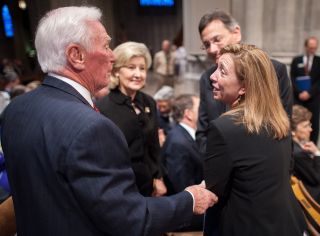
The administrator told Garver he had tried reaching out to the Apollo astronauts about Commercial Crew, but they weren't interested. "Since then," Garver said, "Gene Cernan has been very clear that he talked with Administrator Bolden before the hearing. And from what he could tell, Charlie hadn't been involved."
"So, Charlie reached out to them without me, after I had asked to do it, you know, with a real briefing, and clearly didn't defend the program. So this was the kind of thing I was dealing with," Garver said in the interview.
"When people say, 'you could have never gotten your budget through,' I'm like, no! I think we could have! I think we could have with an administrator on board," Garver said. "Because those astronauts, they wouldn't have wanted to go up against the NASA Administrator."
Garver says she and others worked diligently behind the scenes to make Commercial Crew a reality. "There are a lot of people at NASA, certainly in administration, in industry, places like in the Commercial Spaceflight Federation, who were just like, on board. At 6pm when Charlie left the office, we were, you know, I was across town, we were working it. There were a lot of people involved."
As the Commercial Crew program slowly took shape, Constellation faced restructuring. Garver writes in her book, "I saw the two trains barreling down the same track toward each other and knew if NASA didn't come up with a different program, there would be carnage." After the dust settled, Constellation became the Space Launch System (SLS), which is now integral to NASA's Artemis program. However, to continue Garver's metaphor, Artemis may just be another scoop on top of the industry's "self-licking ice cream cone."
To date, SpaceX has launched a total of seven crewed missions, with four under NASA's commercial crew contracts. The innovative launch company has received several billion in subsidies and contracts from the U.S. government, but it pales in comparison to the development costs for Constellation and SLS, which tops $50 billion, plus an estimated $4 billion per launch. In stark contrast, NASA is hoping to conduct the very first test flight for SLS at the end of next month.
"Everything going perfectly the first time in a test flight is a very high bar. And if they don't meet that bar, then you can imagine…Okay, are they going to put people on the next one? And if they don't, how long is that delay for another test flight?" Garver told Space.com. The author estimates the number of times SLS will fly to be in the "single digits" at most. "It's hard to think of the first one going perfectly," she said.
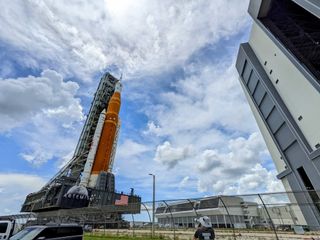
The evolution of Constellation into the Artemis program has not been a smooth transition. NASA's public plan for the program has fluctuated rapidly over the years, adding and removing elements such as the Asteroid Redirect Mission, and the Lunar Gateway.
Now, SpaceX's Starship has been contracted under NASA's Human Landing Services (HLS) program to land astronauts on the moon as part of the Artemis missions. However, the existence and purported capabilities of Starship, which will be able to conduct a lunar landing and return to Earth without the need for SLS or Orion, puts the current Artemis structure into further question.
Garver has her doubts about Artemis's future without Starship, and commends SpaceX's own initiative to develop the vehicle. "Without the advance investment in Starship of SpaceX, Artemis wouldn't be much more than a great name for a human spaceflight program," she said.
"It's really unclear how this is going to work out between SLS, Orion, Starship lander, gateway, and on-ramping other programs," Garver says.
Instead, Garver envisions a NASA where commercial launches are the norm.
"Having the private sector take over would mean NASA is doing more exploration with robotics, seeing how far we can go to find life within our solar system, missions like Europa. I mean, in the 1990s [NASA Administrator] Dan Goldin was planning a Mars helicopter, a Mars airplane, and Europa mission that had an 'aquanaut' that would go under the ice to detect life. So, there's plenty of vision out there of things NASA could be doing. But the costs are exorbitant. And so far human spaceflight has been taking up a lot of that," Garver said, adding, "I never feel there's a shortage of really important, meaningful things for NASA to do beyond what it is that private industry is willing to put their own money into."
On where NASA might be headed next, and who might be fit to lead the agency, Garver thinks the time is well overdue for a woman to be selected as the space agency's next administrator, though she doesn't expect herself to necessarily be in the running. "I think if I had operated my post-NASA career differently, I could have, and maybe should have, really focused in a way that would set me up to go back as administrator someday. I did maybe the opposite," Garver said.
She did, however, reveal who she thinks may be right for the role. "The sitting deputy tops the list, in my view. Steve Isakowitz is still out there. Laurie Leshin just became the head of JPL. Man, she could, you know, really lead. And that's a fantastic thing. I think Kathy Sullivan, Ellen Stofan, who ran the transition team, there are so many women…"
In her book, Garver tells a story juxtaposing SpaceX's Demo-2 mission with the murder of George Floyd, which sparked civil rights demonstrations nation-wide during the summer of 2020. Demo-2 launched five days after Floyd's killing, and Garver writes of the comparisons made at the time to the Apollo missions and civil rights movement of the '60s and '70s.
Related: SpaceX's historic Demo-2 Crew Dragon astronaut test flight
Two years later, and the United States is seemingly just as, if not more, divided. On June 24, the U.S. Supreme Court announced the overturning of Roe v. Wade, abolishing the constitutional right to an abortion and bodily autonomy for pregnant people. Garver, who lives in Washington D.C., shared where she was when she heard the news.
"I am constantly struggling to find a balance. I was on the [phone] with the Houston NPR radio station on Friday when the ruling came down. I'm hearing [the news] as I'm waiting to be a guest, and I live six blocks from the Supreme Court. So I really wanted to get off the phone, get up there, with my signs where I have been, and be with like-minded people. And [the radio station] did ultimately cancel. 'We're going to reschedule for next week to do this coverage,' they told me."
Coincidentally, NASA was hosting a press conference for the Artemis 1 rollback, which was scheduled to take place an hour after the Supreme Court ruling was announced. That event took place without acknowledgement of the day's earlier news.
"NASA didn't cancel. That's understandable," Garver said. "I think for a long time ... this is part of the theme of the book — NASA has been disengaged from the primary national agenda, and we were at our best when we were aligned with it. Of course, people at NASA yearn for that — the presidential attention, people on the street saying, 'you're helping us beat the Soviets,' or whatever it is. You know? I happen to think we could align better with it, and would get more support from a more broad congressional base if we didn't put our heads in the sand, but embrace the change. I mean, we're a futuristic agency! But it's very hard for NASA because people are drawn to it who want to do what we've been doing. They're drawn to it because the people who were their heroes were there, but as a public agency … they don't feel they can make any policy judgments … And I think we shouldn't be as timid to weigh-in on these things."
Garver ended the interview with a reflection on how far commercial crew has come since her first involvement with NASA in the '90s, and the importance of continued innovation in the space sector.
"This transformative launch industry that we've been able to see happening, this lowering of the costs of space, that's what it's about. It's about seeing more people and activities from the vantage of space. They're going to come up with ideas, they're going to bring on in their own interests, bias talents. It's only because we have space that we can even know what's happening everywhere instantaneously. And where we are, it's a paradigm shift that we need to make sure we take advantage of, because we have this unique point in time where I think we're able to help humanity through our space program."
Follow us on Twitter @Spacedotcom or on Facebook.
Join our Space Forums to keep talking space on the latest missions, night sky and more! And if you have a news tip, correction or comment, let us know at: community@space.com.

Josh Dinner is Space.com's Content Manager. He is a writer and photographer with a passion for science and space exploration, and has been working the space beat since 2016. Josh has covered the evolution of NASA's commercial spaceflight partnerships, from early Dragon and Cygnus cargo missions to the ongoing development and launches of crewed missions from the Space Coast, as well as NASA science missions and more. He also enjoys building 1:144 scale models of rockets and human-flown spacecraft. Find some of Josh's launch photography on Instagram and his website, and follow him on Twitter, where he mostly posts in haiku.
